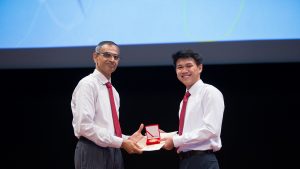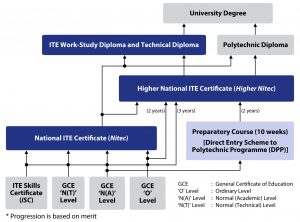
Photo credit: ITE
The Institute of Technical Education (ITE) is one of the post-secondary educational routes in Singapore which has been garnering mixed impressions from Singaporeans for decades.
ITE courses generally have higher cut-off points so they’re often deemed as “easier” to get in and hence regarded as a “less successful” option. Many even associate ITE with the negative mnemonic “It’s The End”.
But of recent, ITE is gaining recognition from the public as a respected educational institution.
Positive media coverage

Media portrayal plays a big role in shaping public opinion. Be it big formal news publications or media companies, there is an increasing trend of highlighting the positive sides of ITE.
These include our local news publication, The Straits Times, featuring “10 famous people who graduated from ITE or polytechnics”, and online news service, Mothership.sg, posting a video “ITE graduates react to Singaporeans’ impression of ITE”.
Some of the positive aspects of ITE that have been underlined:
Lots of hands-on learning

Photo credit: ITE
As its name suggests, ITE focuses on technical education, which means that students gain maximum exposure to real-world practices, gain more experience and become industry-ready when they step out into the workforce.
ITE offers many special courses, such as Beauty & Wellness Management and Fashion Apparel Production & Design, and they provide the necessary equipment to give students an experience that is as realistic as possible. For example, aerospace students get to learn with an actual aircraft.
Unlike most institutions which place the bulk on their emphasis on theories, ITE allocates of their curriculum 70% to practical training and 30% to theoretical lessons, which calls out to many students who would much prefer practical learning.
Contrary to the misconception that ITE students “don’t have a good future”, their rich experience levels are highly sought after by employers.
Government support

Photo credit: ITE
Our local government also shows support for ITE by providing them with financial assistance, subsidies and rewarding them for their achievements, so that students do not have to give up on their studies because of financial struggles.
On top of that, SkillsFuture, a government-initiated movement providing Singaporeans with “the opportunities to develop their fullest potential throughout life”, also promotes the work-study diploma for fresh ITE graduates to secure a job related to their discipline of study with mentorship.
Students get to work and study at the same time, which is an attractive opportunity to young students who wish to gain some financial authority and/or work experience without obstructing their education.
Debunking the stereotypes

Photo credit: ITE
ITE students do have many opportunities to excel and have equal chances of succeeding in life.
They are eligible for many awards, including character awards:
1) Good Progress Award
2) Edusave Awards for Achievement, Good Leadership and Service (EAGLES)
3) Edusave Character Award (ECHA)
4) Edusave Skills Award (ESA)
5) ITE Arts Excellence Award
6) ITE Sports Excellence Award
7) ITE CCA Medal
8) ITE Student Commendation Award
9) Lee Kuan Yew CCA Award
10) Lee Kuan Yew Model Student/Trainee Award
11) Lee Kuan Yew Technology Award
Opportunities after ITE

Photo credit: ITE
Many may have the misconception that students might struggle with limited options upon their graduation from ITE.
But the truth is that there are many routes for ITE students to pursue even after their graduation from ITE.
After attaining a Nitec or Higher Nitec, students can pursue a Work-Study Diploma and Technical Diploma, or a diploma in a polytechnic.
Of course, a university degree is definitely in reach for ITE graduates.
Furthermore, when ITE graduates step out into the workforce, their rich technical experience sets them apart and they are welcomed with many job opportunities.
Conclusion

Photo credit: ITE
Though ITE has been commonly misunderstood and piled with negative stereotypes for decades, there is now more awareness raised on the potential future opportunities of attending the technical education institution.
With that being said, I hope that students would choose what’s truly best for them, instead of allowing themselves to be limited by stereotypes.
What are some of the inspirational ITE stories that you’ve heard? Share them with us in the comments section.
